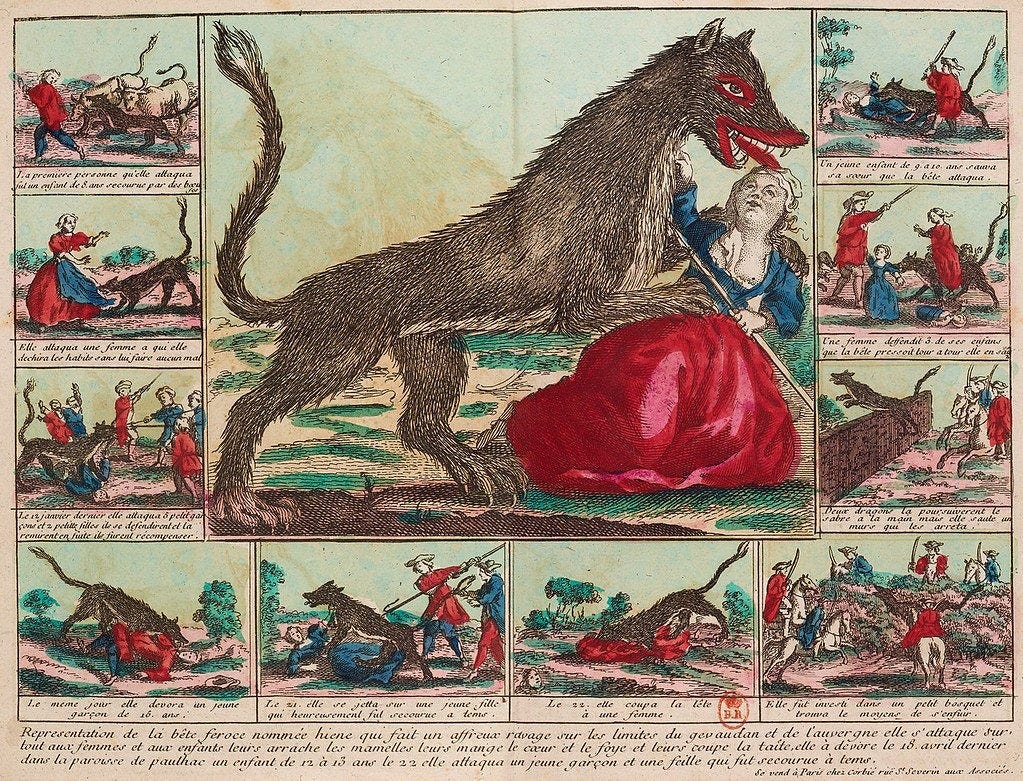It’s Thursday Things! This week we explore the mind, hype werewolves, and pay an online visit to Picasso.
“It wasn’t me.” Photo by Michael LaRosa on Unsplash
If you enjoy this edition, please click the heart icon in the header or at the end of the post to let me know.
Werewolves of yesteryear
I’m generally familiar with the story of the so-called “Beast of Gévaudan” that terrorized that region in southern France back in the 1860s. It’s a famous bit of werewolf lore.
There was strangely slow-paced film based on those events, Brotherhood of the Wolf (2001), that it makes me drowsy even to recall watching. How do you make a boring werewolf-themed movie? Be a French director, apparently.
While there truly was some kind of dangerous animal running wild and killing people, the sensation surrounding the events was one of the first mass media driven public panics. That is the angle that this Open Culture article explores:
How the 18th-Century French Media Stoked a Werewolf Panic
“In the 1760s, nearly three hundred people were killed in a remote region of south-central France called the Gévaudan (today part of the département of Lozère),” says the Public Domain Review. “The killer was thought to be a huge animal, which came to be known simply as ‘the Beast’; but while the creature’s name remained simple, its reputation soon grew extremely complex.”
In the press, which speculated on this fearsome creature’s preferred methods of attack (decapitation, blood-drinking, etc.), “illustrators had a field day representing the Beast, whose appearance was reported to be so monstrous it beggared belief.”
Scary werewolf of yore. Film at 11! Source: Open Culture
As with modern media obsessions, the story was hyped to the point that the whole country was in a frenzy and the government felt the need to take action:
By the winter of 1764–65, “the attacks in the Gévaudan had created a national fervor, to the point that King Louis XV intervened, offering a reward equal to what most men would have earned in a year.” In September of 1756, a lieutenant named François Antoine “shot the enormous ‘Wolf of Chazes,’ which was stuffed and put on display in Versailles.”
And then, again like modern media, the story was dropped suddenly as some new topic dominated the headlines:
This didn’t stop the killings, but “by now the Royal Court had lost interest. The story had played itself out, and public attention had moved on to other matters.
Perhaps the media beast is the real werewolf?
New test to detect dementia early
As amazing medical advances over the last, say, fifty years or so, along with other factors have led to people living significantly longer than in past eras, there has been a concurrent rise in the prevalence of dementia and other cognitive diseases.
Put plainly, people who may in the past have developed dementia had they lived long enough didn’t live that long. Now more of us do, so more of us have to deal with cognitive issues eventually.
This makes the search for better methods of early detection of dementia more urgent. There are many approaches — brain scans, blood tests, DNA screens. But sometimes the low tech route is as good or better.
New Test Could Tell if You Have Early Signs of Dementia With High Accuracy
A new cognitive screening tool developed by Australian researchers to gauge six critical aspects of people's brain function could help. Like any and all of these potential diagnostic aids, the tool needs further validation in larger studies, yet a recent evaluation has concluded it is acceptably accurate.
So far, 526 people have tested the screening tool, a 46-item questionnaire from which their cognition is scored across six domains: memory, language, orientation, attention and concentration, executive function, and ability to copy and draw geometric figures, such as a clock.
Here is the kicker for this test:
This last domain, what's known as visuoconstruction abilities, requires fine motor skills, spatial awareness, as well as planning, one of many executive skills.
Called the 'McCusker Subjective Cognitive Impairment Inventory', the tool captures people's concerns about their current mental capacity. This subjective measure often serves as an early warning sign of declining cognitive abilities, foreshadowing dementia or at least placing individuals in a higher risk category so their health can be monitored more closely.
This has potential, although not all experts are sold on the reliability of self-assessment based detection. Another approach gaining ground uses AI:
Alternatively, researchers have recently tasked artificial intelligence with scanning health records to spot patterns in conditions that may be connected to the onset of Alzheimer's disease. But this relies on doctors diagnosing those conditions – and those connections truly reflecting Alzheimer's risk.
Read all about it in Age and Ageing at The McCusker Subjective Cognitive Impairment Inventory (McSCI): a novel measure of perceived cognitive decline
Picasso digital archive
If you love the art of Pablo Picasso, you can now view thousands of his works without going to Spain or other locations where they are on display.
Thousands of Pablo Picasso’s Works Now Available in a New Digital Archive
Now, you don’t actually have to make the trip to Paris to see these collections, or at least an increasingly large portion of their holdings. As Sarah Kuta reports at Smithsonian.com, thousands of Picasso’s artworks are “now accessible from anywhere with an internet connection, thanks to a new online archive created by the Picasso Museum. The museum has digitized thousands of Picasso’s artworks, essays, poems, interviews and other memorabilia, including items that have never been seen by the public before.” The project began last year, with the digitization of “around 19,000 photos”; if all goes according to plan, the museum will eventually make “an additional 200,000 documents” available online.
The archive link is here: https://cep.museepicassoparis.fr/
Thank you for reading!
Please click the hearts, leave a comment, and use the share feature to send this issue to a friend who might enjoy it. See you next Thursday!




